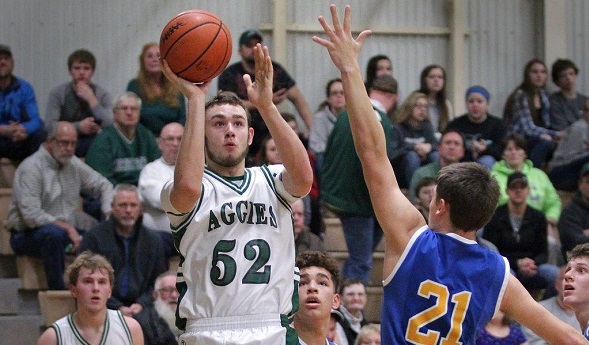
Sand Creek Celebrates Long-Sought Success
By
Chip Mundy
Special for Second Half
February 24, 2017
By Chip Mundy
Special for Second Half
SAND CREEK – It is a season of special anniversaries for the Sand Creek boys basketball team.
 It's also becoming a special season.
It's also becoming a special season.
Twenty-five years ago, Sand Creek made its only appearance in an MHSAA championship game, losing to Muskegon Western Michigan Christian in the Class D Final.
Twenty years ago, it won the Tri-County Conference title – a feat it had not repeated until Tuesday night when the Aggies downed Ottawa Lake Whiteford 55-40 to remain undefeated and win its first conference championship since 1997.
“It's awesome; it hasn't been done in 20 years,” junior point guard Noah Hague said. “It's very special to be a TCC champ and be a part of Sand Creek history.”
While preseason expectations were high, not many could have predicted a 17-0 start and a No. 4 ranking in The Associated Press’ Class C state poll. But that's where the Aggies are after an 11-11 season last winter that was the first time in a decade Sand Creek reached the .500 mark.
At Sand Creek, football has been the high-profile program with 17 postseason appearances from 1984-2008, including eight trips to the MHSAA Semifinals and one to the Class DD championship game. However, from 2009-2015, the football team had just one playoff appearance and even endured a winless season – but last fall the Aggies rebounded to make the playoffs.
Senior Michaja Wilson played quarterback in the fall, and he starts for the basketball team.
“We had a good year in football,” he said. “We went 8-1 in the regular season, but the last couple of years we were under .500. To bring what we did in football and put it on the basketball court has definitely put us on the map.”
Coach Tory VanSickle believes the football success helped the basketball program.
“They realized how much support you can get in a small town like this when you win games,” he said.
Laying the groundwork
In VanSickle, Sand Creek hired an experienced basketball coach three years ago who had guided varsities at Addison, Hudson and Onsted. He knew it was going to take time to get his new program running in the right direction.
“It was somewhat easier for me coming in as opposed to the last job I had because they hadn't been successful, so the kids were willing to buy into what we wanted to do,” VanSickle said. “The hardest part was getting them to buy into something new that wasn't necessarily best for the team at that time but was best for the program to get back in the right direction.
“For them to buy into playing man-to-man the first year - and now we're not playing that at all. We are pressing a lot and playing a lot of zone and letting the kids do things that they are comfortable doing right now.”
The first year, the Aggies finished a few more wins under .500 but advanced to the District Final before losing. Last year, they won 11 games but again lost in the District Final.
“It was a feather in our cap to get to the District Finals the first year, and the second year was kind of a kick in the teeth to not be able to seal the deal,” he said. “They set the goal this year to win the conference and win the District. We hope to readjust the goals as we go along.”
VanSickle said he saw hints of what has turned out to be a special season a year ago.
“Last year, we lost at least five games that we had in the fourth quarter and gave away in some shape or form,” he said. “I thought we could have been a little better last year, so we might have snuck up on a few people early this year who thought we were just a .500 team from last year. I thought we were more like a 13-7 team.
“We expected to win 15 games and, if we were coachable and truly team players, we thought we had a chance of doing what we're doing. We hadn't been truly coachable or truly team players in the two years prior. We've been a little bit stubborn about changing and somewhat individualistic – and not on purpose, just not recognizing when to pass up a pretty good shot for a really good shot. Make two more passes and realize the impact that has on a team. When everyone touches the ball and we score, everybody plays better defense. When you make one pass and score, you lose some of that camaraderie.”
Making a season special
It was a different summer for the Aggies. Instead of long road trips to scrimmage teams, Sand Creek stayed close to home and worked on fundamentals.
“We spent our summer in this little old pole barn basically,” VanSickle said of the school gymnasium. “We didn't go to any team camps, we didn't go play any games against anyone other than we scrimmaged Addison once and Grass Lake once. The rest of the time we've been in here with the football team lifting weights.
“We tried to build ourselves from the ground up. The year before we played 30-some games, but it's so hard in the summer with kids playing baseball and 7-on-7 football. We would get somewhere and have five kids. It was frustrating more than anything, and it was a real eye-opener for me. This summer we got a lot more work done because we had kids around, and we could keep them for another hour or hour and a half that we would have spent on the road.”
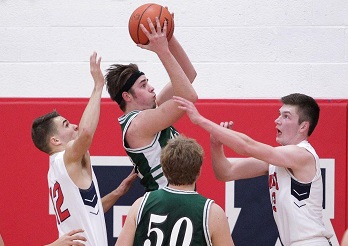 Sand Creek won its first six games with relative ease. Each of the first three victories were by more than 20 points, and the Aggies didn't have a single-digit win until their seventh game. That opened some eyes on the team.
Sand Creek won its first six games with relative ease. Each of the first three victories were by more than 20 points, and the Aggies didn't have a single-digit win until their seventh game. That opened some eyes on the team.
“At the beginning of the season, we were playing good as a team,” Hague said. “The first couple of games we blew teams out, and in the past those games had been closer. So playing as a team and blowing them out felt good because in the past they had been close games.”
A five-point win at Adrian Madison was next, and it, too, was a key victory.
“Beating Madison at their place was really good for this group of guys because Madison has sort of owned Sand Creek for the last decade,” VanSickle said. “That one let us know we could play with good teams.”
Four double-digit wins followed, and one of those wins came against a then-unbeaten Ottawa Lake Whiteford squad. The 70-53 road victory was a confidence-builder for certain.
“Honestly, I didn't expect to be undefeated,” senior Hunter Gallagher said. “I knew that Madison, Summerfield and Whiteford were going to be good, so I didn't expect to go undefeated.
I think it was after we beat Whiteford the first time. When you beat a good team like Whiteford, you get the rest of the teams' attention.”
Two games later, Sand Creek played what Wilson called “an awful game.”
“We went to Summerfield – their gym is haunted; there is something wrong with their gym – and we were down by seven with two minutes to go, and we ended up coming back and winning,” he said. “It was an awful game, but we ended up winning by one, and we haven't had any close games since.”
It might have been “an awful game,” as Wilson said, but it was a meaningful game, too.
“We saved ourselves when we went down to Summerfield,” VanSickle said. “It's a team we always struggle with; we struggled with them at home and trailed by 10 in the first half and ended up beating them in the second half.
“We were down seven with a minute, 40 to go and pulled it out 49-48. That game told us we had what it took to win those close games. We really hadn't been in many close games.”
The Aggies continued to steamroll opponents, and going into Tuesday night's home game against Whiteford, they needed to win to clinch the outright conference title. A loss likely would have left Sand Creek as co-champion.
“After having a year like this, you don't want to stub your toe at the end,” VanSickle said. “We didn't want to share the title.”
Sand Creek beat Ottawa Lake Whiteford 55-40 to win the Tri-County Conference championship. It was the ninth TCC title for Sand Creek, and seven schools have won the conference since the last time Sand Creek did it. Thirteen players got into the game for Sand Creek.
“We have 14 on the team, and 11 or 12 play in the first half,” VanSickle said. “Our big three kids are Parker Randall, Noah Hague and Hunter Gallagher. They all average between 14 and 15 (points per game), so they're all bunched.”
Gallagher came into the week averaging 15.2 points and 6.6 rebounds per game. Randall is at 15.1 points per game with 5.9 assists and 5.5 steals, and Hague is scoring 13.7 points per game with 4.8 rebounds and 2.4 assists.
“Noah's the point guard,” VanSickle said. “He's 6-3 and the best free-throw shooter in the county and gets to the basket. He's our second-best post-up guy besides Hunter.”
Wilson, one of four senior starters, is averaging 5.3 points, 3.5 rebounds and 2.8 assists per game, and he has scored in double figures in three of the past four. Logen Gallagher – twin brother of Hunter Gallagher – is averaging 6.0 points, 4.1 rebounds and 2.0 assists per game.
“Wilson is starting to come on, and Tim Gritzmaker has started at the wing for us,” VanSickle said. “He's a good 3-point shooter and a smart kid, Logen comes in and backs Tim up, and he's another 6-3 kid who can shoot the ball from a ways out and can score from inside.
“We have a lot of seniors who can do a lot of different things. We bring in Jake Houston, who was an all-conference center in football. When we need a guy to get rough and tough and rebound the ball, Jake plays. When you have a team that is trapping and pressing, Jake watches. They all buy into it. No one gets mad about not playing. They understand the goal is the name on the front of the jersey.
“There are five juniors off the bench who play between three and four minutes in the second quarter, but they get some time so hopefully next year we don't have a real letdown in terms of our experience. Most of our scoring comes from our seniors, but our juniors are getting game experience and letting our seniors get breaks. The depth has been huge for us.”
Of course, the mission is not complete. Sand Creek has a shot at an undefeated regular season, and then it will try to win its first District championship since 1996.
“We went to the District finals in football, and in basketball the past two years we went to the district finals, and we ended up losing every time,” Wilson said. “Quite honestly, I'm sick of losing District Finals, so I am hoping we can win a District and then keep going.”
That attitude is contagious.
“We came into the season feeling like we needed to win the league, and we needed to win the District,” Randall said.
The architect
VanSickle has a connection with the Sand Creek program from the magical 1992 season. When the Aggies played for the Class D championship, VanSickle called the game for WLEN radio.
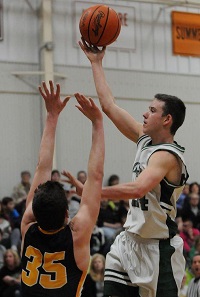 “I worked for the radio station and announced that game, and Jason Boring, the best player off that team, is now helping me coach here,” VanSickle said. “So I've kind of come full circle a little bit.”
“I worked for the radio station and announced that game, and Jason Boring, the best player off that team, is now helping me coach here,” VanSickle said. “So I've kind of come full circle a little bit.”
VanSickle comes from a coaching family, and a successful one at that. His father, Denny, coached Onsted to an undefeated regular season in 1969-70, and his uncle Steve Prange coached Onsted to an unbeaten regular season in 1982-83.
VanSickle hopes to add another unbeaten team to the family circle.
“I remember that 1982-83 team was a deep team and a lot of guys who could play,” he said. “They kind of remind me of ourselves with a lot of depth and a lot of guys who can bump down and play a different spot depending on the opponent. I was at the age when I was pretty impressionable, so a lot of those guys were guys I looked up to.”
Now, the Aggies are looking up to him, and in three years, they have totally bought into what VanSickle is selling.
“I think when coach came in, we had more freedom to play our game instead of what he wants us to do,” Gritzmaker said. “He wants us to play within ourselves and do what we can do. He likes what everybody brings to the table.”
VanSickle has the Aggies playing a full-court press, and that aggressive attitude has been welcomed by the players.
“I'm liking the press,” Hague said. “It helps keep the game high-tempo, and that benefits us more than the other team playing, at that fast pace.”
With a high-tempo game comes some mistakes, and Hunter Gallagher said Coach VanSickle sent a message about those miscues.
“If we turn the ball over, he expects us to hustle back on defense,” Gallagher said. “He says that instead of complaining about something we did wrong on offense, take it out on the other team by playing defense.
“It was about halfway between my sophomore year when I really understood what he wanted to do offensively and defensively.”
VanSickle seems to be a perfect match. He is a basketball coach who has resurrected his program at a school that is known for football. That is not always a simple thing to do.
“It's fun to be a part of a resurgence, and it's good for me, too,” he said. “I kind of needed a resurgence after my last job. I've been kicked in the teeth a little bit, so it's nice to see the team and our school have a little revival, and myself, also.
“They are really starting to buy in, especially in the last month as we started to get ranked in the state. We talk and say, 'Hey, it's just an opinion,' but it does draw some attention, and it's a matter of respect, not only for us but for our conference, too.”
And the Sand Creek community has noticed. In the middle of winter, fans are parking near the football field and walking past the green bull outside the gym to watch the basketball team.
“The crowds have been great,” VanSickle said. “We're getting a lot of the old-timers to come out, and they take the young kids under their wing. You can see them pointing at the kids during the game and talking to them after the game. It's neat to see.”
And likely, vice versa.
 Chip Mundy served as sports editor at the Brooklyn Exponent and Albion Recorder from 1980-86, and then as a reporter and later copy editor at the Jackson Citizen-Patriot from 1986-2011. He also co-authored Michigan Sports Trivia. E-mail him at [email protected] with story ideas for Jackson, Washtenaw, Hillsdale, Lenawee and Monroe counties.
Chip Mundy served as sports editor at the Brooklyn Exponent and Albion Recorder from 1980-86, and then as a reporter and later copy editor at the Jackson Citizen-Patriot from 1986-2011. He also co-authored Michigan Sports Trivia. E-mail him at [email protected] with story ideas for Jackson, Washtenaw, Hillsdale, Lenawee and Monroe counties.
PHOTOS: (Top) Sand Creek's Hunter Gallagher pulls up for a shot against Adrian Madison. (Middle) Noah Hague splits a pair of defenders while retaining possession. (Below) Parker Randall rises above an opponent to take a shot. (Photos courtesy of the Adrian Daily Telegram; top and middle by John Discher and below by Deloris Clark-Osborne.)
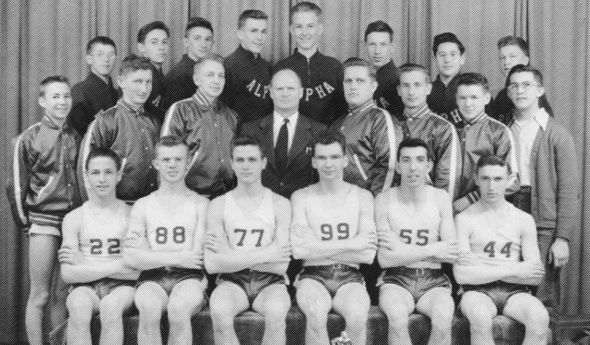
Before the Bridge: Class E & the UP
July 31, 2017
By Ron Pesch
MHSAA historian
This is the final part in a series on MHSAA tournament classification, past and present, that has been published over the last two weeks and originally ran in this spring's edition of MHSAA benchmarks.
The stories are worthy of the silver screen.
Long lost legends of lore, forgotten by most in the Lower Peninsula of the state of Michigan.
Absurd anecdotes of basketball played behind glass, and out-of-bounds lines painted on walls.
Tales of overlooked places like Trenary and Champion and Doelle and Watersmeet.
This is the story of MHSAA Class E basketball.
From 1932 to 1947, Michigan's Upper Peninsula did not compete in the state-sponsored basketball tournament. Instead, the U.P. held a separate basketball tournament, crowning champions in Classes B, C and D. In 1941, the state added a fifth classification – Class E, comprised of schools with a student body numbering 75 or fewer. A fourth bracket was added to the U.P. tourney.
Following the 1948 season, the Upper Peninsula returned to the state tournament. Winners of the traditional U.P. tourney were pronounced regional champions, and advanced to the state quarterfinals in Classes B, C and D. However, since there were no Class E schools with basketball teams in the Lower Peninsula, the winner of the U.P. tournament crown was proclaimed Class E state champion. This arrangement continued through the spring of the 1960 season.
Since they were the state's smallest high schools, the gymnasiums came in all shapes and sizes. Some sported a center circle that intersected with the top of the key. Basketball courts that doubled as a stage required netting to keep the kids and the ball on the court and away from the audience seated below.
Fred Boddy, a former coach at Champion, recalled his first visit to Doelle. Located in copper country near Houghton, the hosts were the proud owners of “the smallest” gym in U.P.
“I couldn't believe my eyes. ... Here on the second floor were windows and bleachers all around filled with fans. The gym, of course, was located on the first floor, but to get into the gym one had to go around to the back of the school to enter through the boiler room to the locker rooms, which opened onto the gym floor much like a dugout on a baseball field. The players sat on a bench under the wall and could look out and see the game in this manner. The free throw lines intersected and there were no out of bounds lines... the wall itself was ‘out of bounds.’ On the floor during the game were 10 players and two referees. There were no sounds as all the fans were up on the second floor, glassed in.
The cheerleaders tried valiantly to fire up the fans up on the second floor, but the teams couldn't hear in the quiet below. The score clock and statistician personnel were placed in a corner box high over the floor in one corner of the gym. They attained this lofty perch by a ladder that was removed from the trap door after all three were in position and the game could thus commence. The timer then tied a rope around his ankle. To send a sub into the game the coach would send the player along the wall heading for this rope. He would pull the rope causing the timer to look down through the trap door and at next opportunity would ring the buzzer and admit this substitute”
Regardless of the challenges presented by these cracker-box gyms, the fans loved their basketball. “The enthusiasm was just the same, if not bigger, than schools twice and 10 times their size,” noted longtime U.P. historian, Jay Soderberg.
Coach Joseph Miheve's 1941 Palmer squad captured the state's first Class E title with a 39-28 win over Hulbert at Ironwood. A graduate of Wakefield High School, Miheve had never played high school basketball, serving as the team's manager.
The 1942 tournament, scheduled for March 19-21, was postponed one week because the city of Marquette was more or less taken over “by nearly 1,000 selective service registrants from every county in the Upper Peninsula” who had another and more serious battle in mind – World War II.
Palmer, this time coached by Elvin Niemi, repeated in Class E with a 37-31 victory over Bergland. It was Palmer's 32nd consecutive victory.
No tournament was held in 1943 due to the involvement of the United States in the war. In the 1944 championship game, Cedarville jumped out to a 19-14 first quarter lead but was held to 24 points in the remaining periods and fell to Amasa, 51-43 at Ishpeming.
Trenary made its lone Class E finals appearance in 1945, losing to Bergland 49-39 at Ishpeming, while the Alpha Mastodons won their first U.P. title since 1934 with a 48-28 win over Champion in 1946. It was the second of five Class E titles for Alpha coach Gerhardt “Gary” Gollakner, one of the finest coaches to come out of the U.P. Gollakner had coached at Amasa two years earlier, and his Mastodons would earn three additional titles during the 19-year run of the Class E championships.
Bergland became the tourney's second two-time winner in 1947, with a 40-37 win over the Perkins Yellowjackets. Perkins made four trips to the Class E finals over the years, including an appearance in the final year of the tournament, but came away empty-handed each time.
The Nahma Arrows made their first appearance in the championship in 1951, losing to Michigamme. Led by coach Harold “Babe” Anderson, a cage star at Northern Michigan College during the early 1940s, the Arrows returned to the finals in 1952. Nahma finished the year with a 21-0 mark and a 64-44 win over Marenisco for the crown.
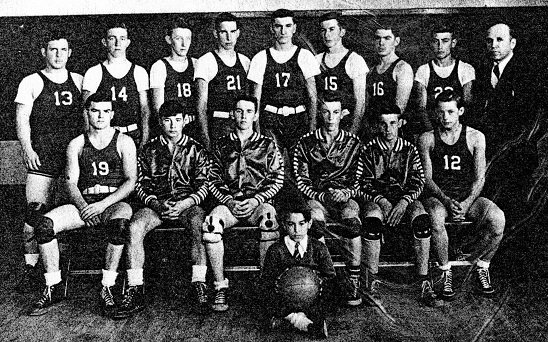 The two teams met again in a finals rematch the following year. The scored was tied six times, while the lead changed hands seven times in this barnburner. With 15 seconds to play, Nahma led 64-60. Marenisco's Robert Prosser hit a jump shot, then teammate Bill Blodgett stole a pass and scored to knot the game at 64. With two seconds remaining, Nahma's Bernard Newhouse was fouled. Newhouse hit the first free throw, but missed on the second. Teammate Wendell Roddy tipped in the rebound, and the Arrows had their second title.
The two teams met again in a finals rematch the following year. The scored was tied six times, while the lead changed hands seven times in this barnburner. With 15 seconds to play, Nahma led 64-60. Marenisco's Robert Prosser hit a jump shot, then teammate Bill Blodgett stole a pass and scored to knot the game at 64. With two seconds remaining, Nahma's Bernard Newhouse was fouled. Newhouse hit the first free throw, but missed on the second. Teammate Wendell Roddy tipped in the rebound, and the Arrows had their second title.
Alpha returned to the championship circle in 1954 with a 52-48 win over Perkins.
The 1955 title game matched a pair of the finest teams in Class E history. Trout Creek, making its first championship appearance, downed Alpha 84-83 in another Class E thriller. Don Mackey led the winners with 39 points. Tony Hoholek paced Alpha with 31, while junior John Kocinski added 21-points for the Mastodons.
Kocinski, a four-year starter at Alpha, scored 1,782 points during his career, then an all-time U.P. record. He once scored 51 points against Amasa, and could have scored more according to teammate Walter “Slip” Ball. “He refused to shoot in the fourth quarter, and passed up one shot after another,” Ball said.
Without question, Trout Creek was one of the powerhouse squads during the final years of the tourney. The Anglers, coached by Bruce “Pinky” Warren, a former captain of Purdue's football team, made four trips to the finals during the last six years of the Class E tourney. The defending champions downed Alpha in the semifinals of the 1956 tournament, then knocked off Hermansville 86-68 in the finals to repeat. It was a year of celebration for fans of U.P. basketball, as four of the state's five champions – Stephenson (B), Crystal Falls (C), Chassell (D) and Trout Creek (E) – came from Michigan's northern peninsula.
Hermansville returned to the finals in the spring of 1957 and earned its second Class E title with a 77-51 win over Michigamme at Escanaba. Trout Creek downed Perkins 61-41 for their third crown in 1958.
The 1959 championship, hosted at Northern Michigan College's fieldhouse, was a showdown of the U.P.’s only undefeated squads, Trout Creek and Nahma. Trout Creek was riding a 24-game winning streak that dated back to the 1958 season. A scoring machine, Warren's Anglers averaged 81.7 points per contest. Nahma, 19-0 on the season, boasted the U.P.'s strongest defense. Still coached by “Babe” Anderson, the Arrows had allowed an average of 38.2 points per game. Led by senior Warren Groleau, Nahma had been last defeated by Trout Creek in the semifinals of the 1958 tourney.
Leading 25-15 at the intermission, Nahma matched Trout Creek point for point in the second half for a 55-45 victory.
Hermansville, behind Richard Polazzo's 29 points and Irwin Scholtz's 27, downed surprise finalist Perkins 72-50 in the 1960 finale, to end this chapter in MHSAA history.
Today, most of the former Class E high schools are long gone. Many have closed their doors and consolidated with other area schools. Amasa and Alpha merged with Crystal Falls to form Forest Park. Palmer is now part of the Negaunee school system. Bergland and Trout Creek joined forces with Class D Ewen to form Ewen-Trout Creek. Hermansville combined with Powers to form North Central, to name but a few. A few remain: Dollar Bay, Marenisco (now Wakefield-Marenisco) and Watersmeet, and their enrollments are much the same as in the glory days of the state's fifth classification.
Author’s note: Special thanks to Jay Soderberg and Roger Finlan, who assisted in gathering statistics and quotes used in this article. Thanks also to Dick Kishpaugh, Bob Whitens, Walter “Slip” Ball, Dennis Grall, Fred Boddy, Bruce Warren, Gene Maki, Harold “Babe” Anderson and the various personnel at U.P. high schools for their contributions to this story.
PHOTOS: (Top) The Alpha boys basketball team won the 1950 Class E title by nearly doubling up Michigamme, 52-28. (Middle) Hermansville claimed the 1948 title with a 58-38 win over Rockland.

